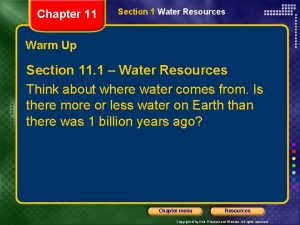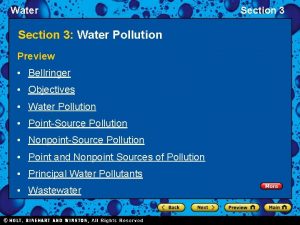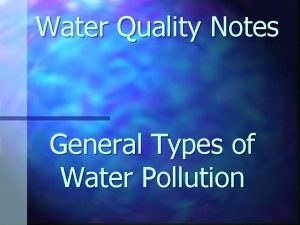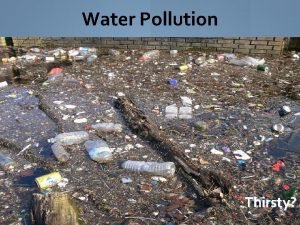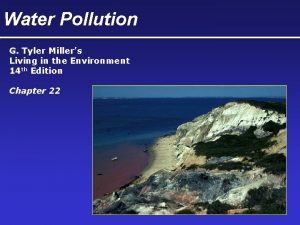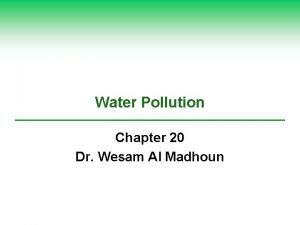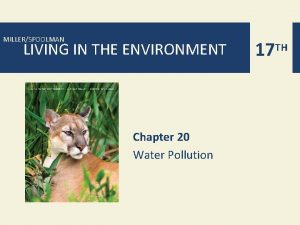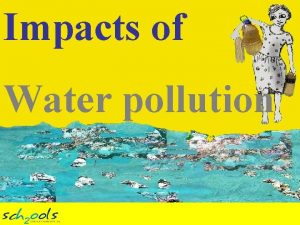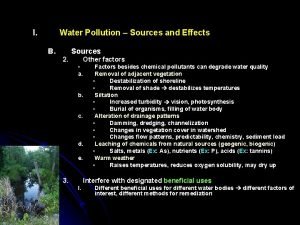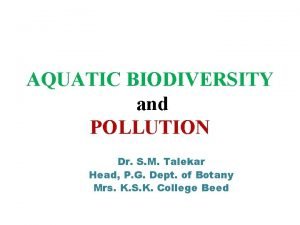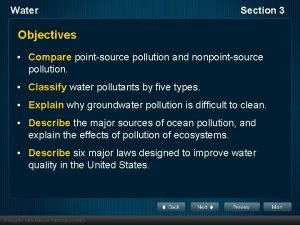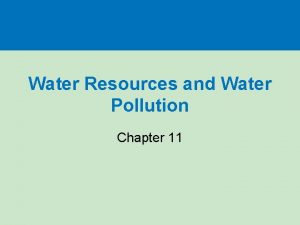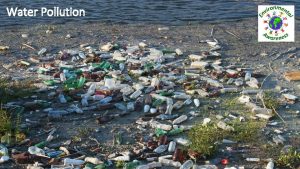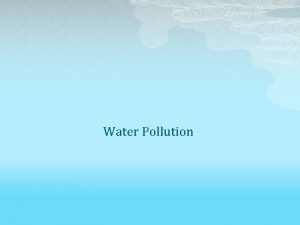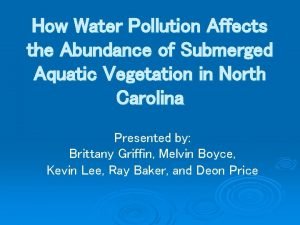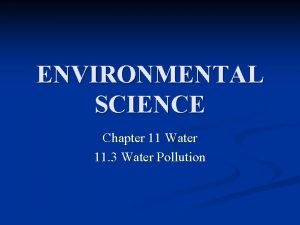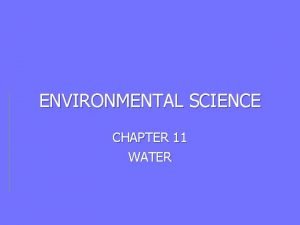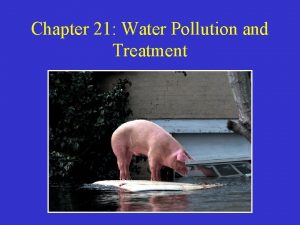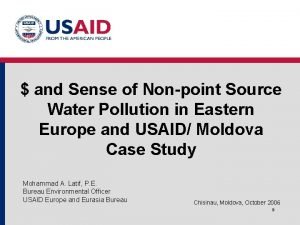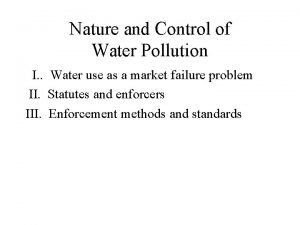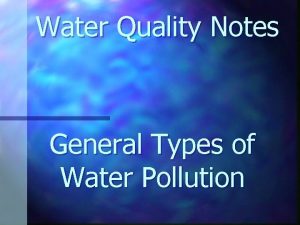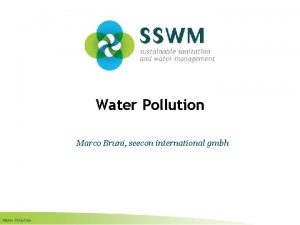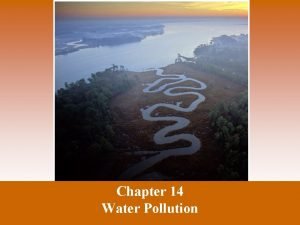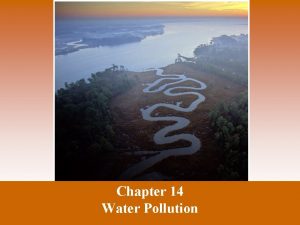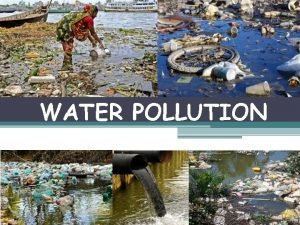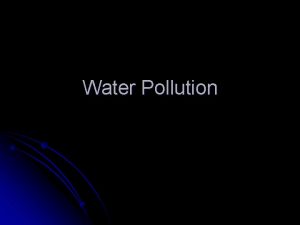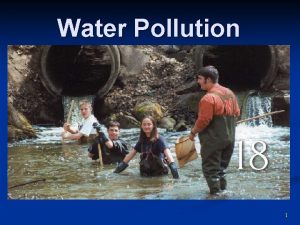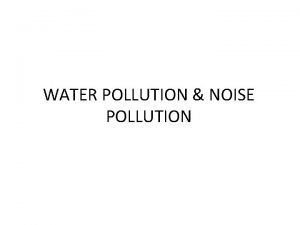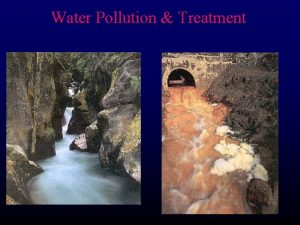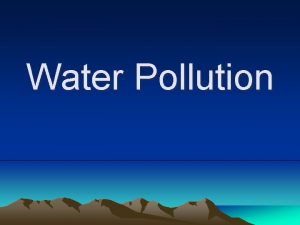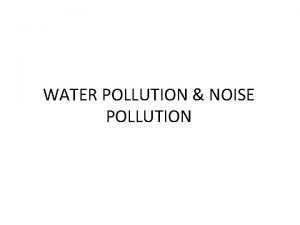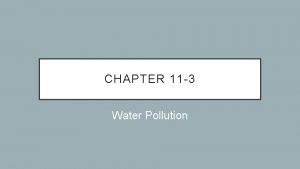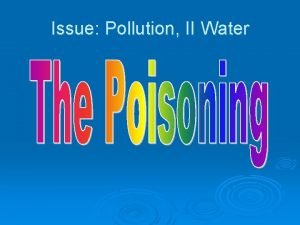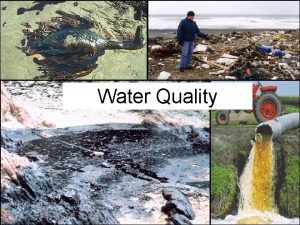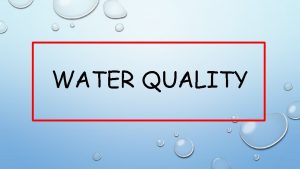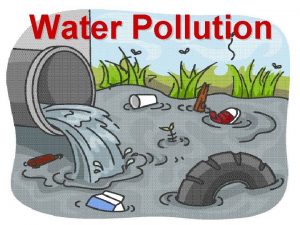Chapter 14 Water Pollution Water Pollution Water pollution






























- Slides: 30

Chapter 14 Water Pollution

Water Pollution © Water pollution- the contamination of streams, rivers, lakes, oceans, or groundwater with substances produced through human activities and that negatively affect organisms. © Point sources- distinct locations that pump waste into a waterway. © Nonpoint sources- diffuse areas such as an entire farming region that pollutes a waterway.

Human Wastewater © Water produced by human activities such as human sewage from toilets and gray water from bathing and washing clothes or dishes.

Three reasons scientists are concerned about human wastewater: © Oxygen-demanding wastes like bacteria that put a large demand for oxygen in the water © Nutrients that are released from wastewater decomposition can make the water more fertile causing eutrophication © Wastewater can carry a wide variety of diseasecausing organisms.

© Biochemical Oxygen Demand (BOD) BOD- the amount of oxygen a quantity of water uses over a period of time at a specific temperature. © Lower BOD values indicate the water is less polluted and higher BOD values indicate it is more polluted by wastewater.

Eutrophication © Eutrophication is an abundance of fertility to a body of water. © Eutrophication is caused by an increase in nutrients, such as fertilizers. © Eutrophication cause a rapid growth of algae which eventually dies, causing the microbes to increase the BOD and decrease oxygen for use by other animals.

Common Diseases from Human Wastewater © Cholera © Typhoid fever © Stomach flu © Diarrhea © Hepatitis

Treatments for Human and Animal Wastewater © Septic systems- a large container that receives wastewater from the house.

Treatments for Human and Animal Wastewater © Sewage Treatment Plants- centralized plants in areas with large populations that receive wastewater via a network of underground pipes.


Treatments for Human and Animal Wastewater © Manure lagoons- large, human-made ponds line with rubber to prevent the manure from leaking into the groundwater. After the manure is broken down by bacteria, it is spread onto fields as fertilizers.

Heavy Metals and Other Substances that can threaten human Health and the Environment © Lead © Arsenic © Mercury © Acids © Synthetic compounds (pesticides, pharmaceuticals, and hormones)

Arsenic in US Water A cancer causing element that is mostly natural – but also a byproduct of mining and wood preservation

World Mercury Production Comes mostly from burning coal – harmful to the nervous system

Acid Deposition and Acid Mine Drainage Caused by gasses from burning coal mixing with water in the atmosphere and coming back to earth, abandoned coal mines that get flooded and water returns to the surface, and mountaintop removal waste is dumped into watersheds.

Syntheic organic compounds © Pesticides kill the target organism, but can also kill/harm beneficial organisms. (DDT) © Inert ingredients in pesticides are classified as trade secrets and most are not required to be tested for safety, so their affects are not known before the product comes on the market. (roundup) © Many pharmaceuticals are considered endocrine disrupters and affect organisms at low dosages – Need more research © Perchlorates used by the military affect the thyroid and hormones in humans. © Polychlorinated biphenyls (PCB’s) used in manufacturing plastics is cancer causing and now banned in the US © Polybrominated diphenyl ethers (PBDE’s) are used as flame retardants in many things and can cause brain damage

Cuyahoga River

Synthetic Organic Compounds Streams in the US contain a wide variety of chemicals. They come from a variety of sources including wastewater, agriculture, forestry, and industry

Sources of Oil Pollution in the Ocean

Oil Catastrophes Oil is highly toxic to all life and is very persistent in the environment. 2010 – Deepwater Horizon explodes killing 11 people and dumping an estimated 780 million Liters of oil in the Gulf of Mexico. 1989 – Exxon Valdez runs aground off of the Alaskan coast spilling 41 million L of crude oil

Ways to Remediate Oil Pollution © Containment using booms to keep the floating oil from spreading. © Chemicals that help break up the oil, making it disperse before it hits the shoreline. These are often highly toxic. © Bacteria that are genetically engineered to consume oil Other Water Pollutants © Solid waste pollution (garbage) © Sediment pollution (sand, silt and clay) © Thermal pollution © Noise pollution

Oil Remediation Methods © All animals must be cleaned by hand using soap. © Surface oil is contained by using booms (plasitic floating barriers) to prevent oil from spreading out. Once contained it can be vacuumed up or burned. © Absorbent materials are used at the coastline to suck up the oil © Dispersants (chemicals) are also used to break up the oil, however they are toxic. © Genetically enginneered bacteria can also be used to clean up oil © Currently no method for dealing with underwater plumes. © High pressure hot water is used on rocky coastlines, but this removes nutrients and sediments necessary for many organisms

Solid Waste Pollution


Sedimentary Pollution © Affects light penetration and aquatic productivity © Can clog fish gills and hinder their ability to get oxygen © Can carry nutrients that cause algal blooms.

Thermal Pollution © When human activities cause a substantial change in water temperature. (Mills and power plants) © Thermal shock – a dramatic change in water temperature outside of the organisms tolerance range. Increases respiration and warmer water contains less oxygen. © EPA regulates this

Noise Pollution © Sounds from ships, air blasts for exploration, and sonar from submarines © Can deafen fish and mammals, affect communication, and affect their navigation.

Water Laws © Clean Water Act- (1972) supports the “protection and propagation of fish, shellfish, and wildlife and recreation in and on the water”. © Issued water quality standards that defined acceptable limits of various pollutants in U. S. waterways. © Safe Drinking Water Act- (1974, 1986, 1996) sets the national standards for safe drinking water. © It is responsible for establishing maximum contaminant levels (MCL) for 77 different elements or substances in both surface water and groundwater.


 Water and water and water water
Water and water and water water Water contamination introduction
Water contamination introduction Chapter 11 section 3 water pollution answer key
Chapter 11 section 3 water pollution answer key Class 8 english chapter 7 water water everywhere
Class 8 english chapter 7 water water everywhere Sources of groundwater pollution
Sources of groundwater pollution Explain water pollution
Explain water pollution Water pollution through the years
Water pollution through the years Point source pollution examples
Point source pollution examples What are the terrible twelve water pollution
What are the terrible twelve water pollution Solutions to water pollution
Solutions to water pollution Land pollution effects on human health
Land pollution effects on human health 8 effects of water pollution
8 effects of water pollution Soil pollution images diagram
Soil pollution images diagram Methods of water pollution
Methods of water pollution Effects of water pollution
Effects of water pollution Ddt water pollution
Ddt water pollution What are 5 effects of water pollution?
What are 5 effects of water pollution? Objectives of water pollution evs project
Objectives of water pollution evs project How to decrease water pollution
How to decrease water pollution Conclusion of water pollution
Conclusion of water pollution Types of water pollution
Types of water pollution Water pollution and unequal distribution illustration
Water pollution and unequal distribution illustration Summary of water pollution
Summary of water pollution Objectives of water pollution
Objectives of water pollution Objectives of water pollution
Objectives of water pollution Thermal pollution
Thermal pollution Introduction of water pollution
Introduction of water pollution Water pollution of observation
Water pollution of observation Control measures of water pollution ppt
Control measures of water pollution ppt High level of pollution
High level of pollution Pollution of water is responsible for
Pollution of water is responsible for


